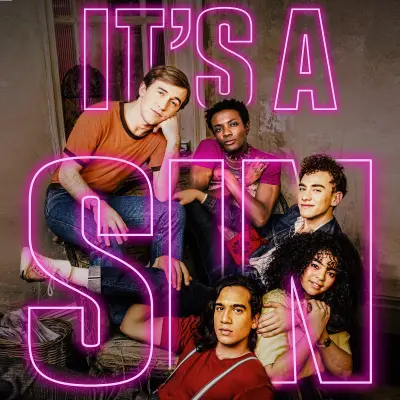It’s a Sin replicates troubling AIDS crisis tropes
-

"With a specifically British inflection, (Russell T.) Davies vividly evokes a climate of fear that saw gay men painted as pitiful victims, or worse, as potential killers capable of spreading the virus into the 'general population' via the blood supply or continued sexual activity," says Brian Mullin of Davies' limited series. "Though many groups were and remain affected by the virus, gay men were singled out in the press and forever associated with it. Queer British filmmaker Stuart Marshall identified the new and harmful media image of the gay 'AIDS victim' in a 1990 essay: 'the object of pity, scorn or contempt who mumbles in a dark corner about his regrets, his fears, the dreadful price he has paid for his sexual freedom and his inevitable and imminent demise.' Watching Davies’ series more than 30 years later, as a person living with HIV myself, I see troubling vestiges of the same moralism: Certain tropes may have mutated since the days when headlines shouted 'Britain Threatened by Gay Plague,' but they are no less pernicious for being less obvious or for coming from the pen of a gay creator. In It’s a Sin, structures of blame and mysteries of transmission drive the narrative, recalling the sensational (and inaccurate) notion, at the center of gay journalist Randy Shilts’ bestselling AIDS history And the Band Played On, that the plague in the U.S. could be traced back to a sexually active gay flight attendant known as 'Patient Zero.' This becomes apparent in the third episode when the innocent, seemingly virginal Colin (Callum Scott Howells) is mysteriously struck down with AIDS-related illness, and Davies’ script fixates on the question of how Colin contracted HIV. The identity of his sole sexual partner is revealed as a shocking plot twist through flashbacks of their sex, distastefully intercut with shots of the dying boy. Davies and his editor bring Colin’s story full circle, reducing him to one type of 'AIDS victim': the innocent naif, doomed from his first sexual encounter. As the series proceeds, an economy of pleasure paid for by death recurs in the script. We watch the protagonist, Ritchie (Olly Alexander), joyously bonk half of London, only to see his sexual enthusiasm grow more ominous as the epidemic advances. Like Colin, he too regresses, first running from the reality of his HIV diagnosis back home to the Isle of Wight, an abject figure begging his (straight) high school crush for oral sex: 'You could just lie back and close your eyes.' Libertine Ritchie becomes the other side of the 'AIDS victim' coin, lashing himself for his compulsive sexual behavior. By the time he’s in the hospital, Ritchie’s internalized so much homophobia that he implicates himself as his own Patient Zero for continuing, pathologically, to have unprotected sex: 'I knew it was wrong and I kept on doing it. I wonder how many I killed?' These two boys represent the sum total of people with AIDS to whom Davies grants major plotlines."
ALSO:
- It's a Sin is a reminder of how far we've come in TV's portrayal of AIDS: "Television is how I first learned about AIDS," says Erik Piepenburg. "I was a teenager in the ’80s in suburban Ohio, before the internet, and I wasn’t taught about AIDS at church, school or home. I got my education from Larry Kramer on The Phil Donahue Show. From TV movies like An Early Frost and The Ryan White Story (now on Netflix). From news coverage of Rock Hudson’s death. From a fierce and furious scene on Designing Women when Julia Sugarbaker (Dixie Carter) verbally beats down a friend who says that AIDS is killing 'all the right people.' It wasn’t obvious to me in the ’80s, but there was a silver lining to learning about AIDS this way. Even flawed portrayals showed me that as gay men were dying and the world didn’t seem to care, still gay men were real and, in many cases, cared for and loved. It was a messy message, but it landed."
- How TV shaped our understanding of AIDS, from NBC's An Early Frost starring Aidan Quinn to St. Elsewhere's 1983 episode "AIDS & Comfort": "It is not an exaggeration to say that television has played an integral part in how many of us came to understand what the letters HIV and AIDS stand for," says Manuel Betancourt. "From medical dramas and procedurals to cable movies and period pieces, American television has as easily reflected as reshaped public opinion on these issues, one fictional character at a time. While unscripted television has broken major ground in this regard — see the impact of The Real World, Project Runway, and RuPaul’s Drag Race, to name but a few — the following history, brief and protracted as it may be, deals exclusively with scripted fare. It offers a glimpse into the way television creators have used the tools of serialized storytelling and the powers of network distribution to grapple with one of the defining crises of the last half century. Take a journey with us through close to 40 years’ worth of TV stories about HIV and AIDS."
TOPICS: It's a Sin, HBO Max, Russell T Davies, LGBTQ
More It's a Sin on Primetimer:- Neil Patrick Harris Joins Doctor Who In Mystery Role
- Insecure, Dopesick and Reservation Dogs are among the winners of Television Academy Honors Award for inspiring social change
- GLAAD Media Awards honor Hacks, Saved by the Bell, It's a Sin, We're Here and RuPaul's Drag Race
- Handicapping the Critics' Choice TV Awards
